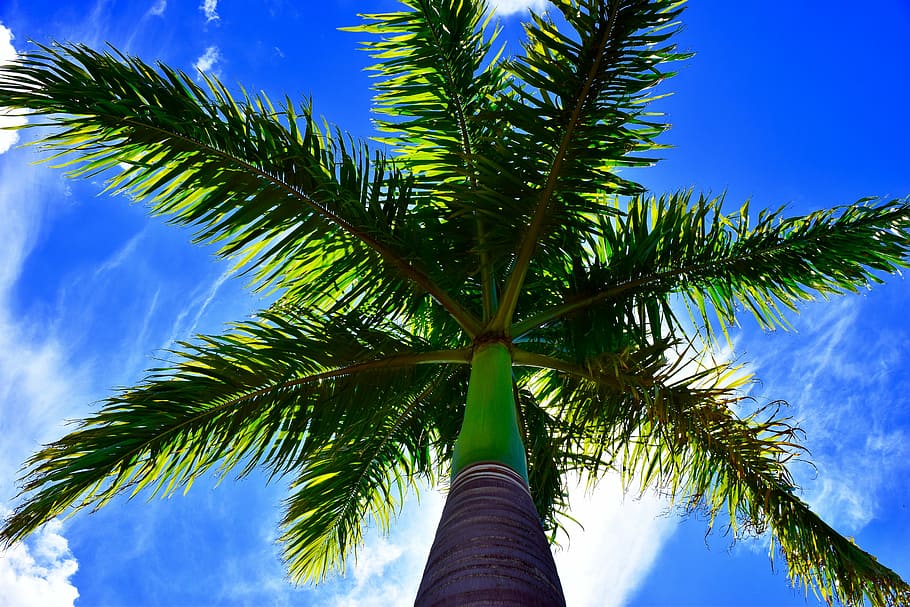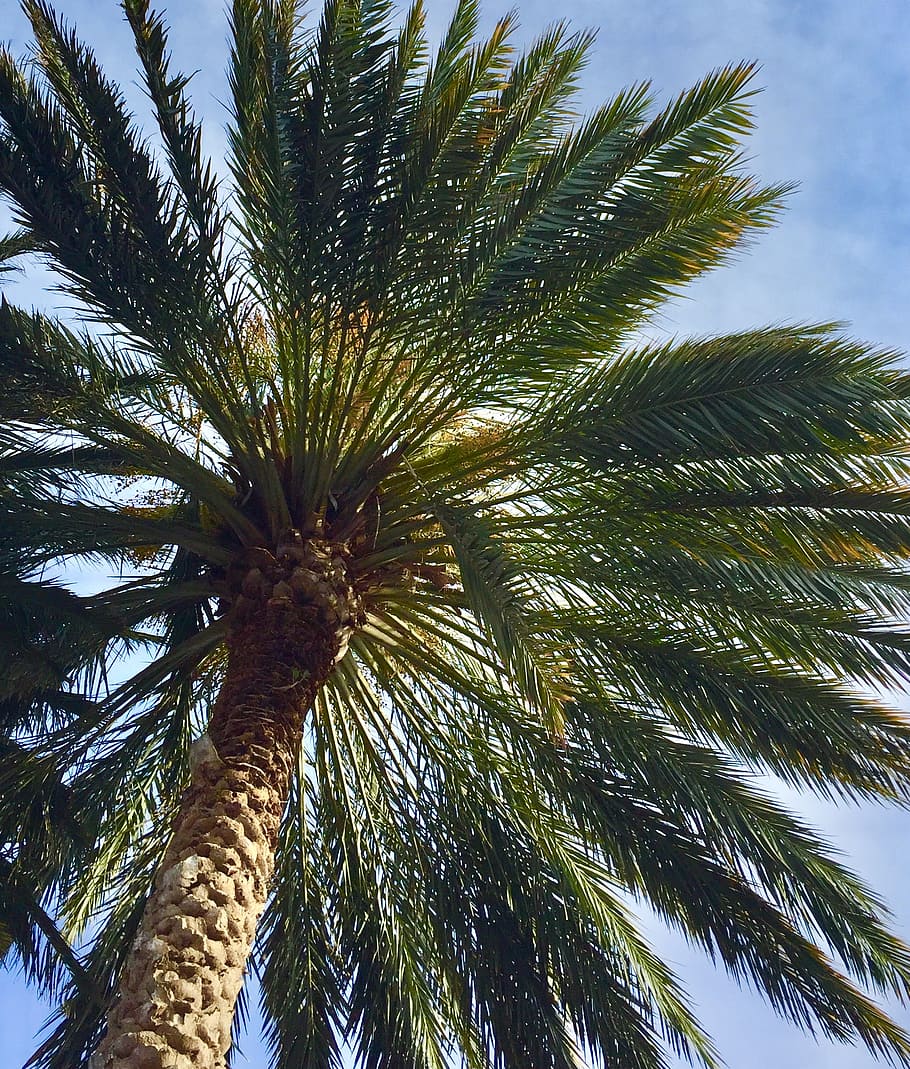Summary
– Anatomical reminders for proper palm pruning
– Pruning palms: several species
– Principles of palm pruning: not necessary per se
– Palm tree pruning techniques: trunk and palms
Depending on the tree species, the pruning method is decisive, whether for the shape of the tree, its health, or to comply with pruning regulations. The pruning of palms differs from hardwoods, softwoods or fruit trees.
Anatomical reminders for proper palm tree pruning
Palms are plants that do not contain wood in the structure of their “stem” called “stipe” or “bole”. They are not, strictly speaking, trees. Sometimes, this does not prevent them from reaching impressive sizes (60 m for Ceroxylon quindiuense).
The stipe is most often unique in palms as in Trachycarpus or Washingtonia. However, some varieties form several trunks, like the date palm (Phœnix dactilifera) or the dwarf palm (Chamaerops humilis).
Palm tree pruning: characteristics of the stipe
The petiole is the stem that carries the palm. The stipe is the part of the trunk that goes from the ground to the first branches:
– It is made up of the stacking of the base of the leaves. These are born in the tuft centre from a single bud located at the stipe top.
– When its base is established, its diameter does not grow anymore. This is why it is not rare to observe variable diameters all along the stipe according to the quantity of water fallen annually or a fall of the reserves due to severe pruning.
– The stipe has no branches even if it sometimes divides in two.
– The palm tree cannot cover its wounds as trees do. A wound in the stipe is therefore irreparable.
Palm tree pruning: leaf characteristics

The adult leaves are fan-shaped (palmate leaves) or fishbone-shaped (pinnate leaves). The Caryota, sometimes found in tropical greenhouses, is an exception with its very divided foliage (bipinnate leaves).
The colour of the leaves is particular to certain palms, such as the Brahea armata with palmate leaves and the Butia capitata with pinnate leaves. Both have bluish-gray leaves.
In some species, such as Washingtonias, the oldest palms remain hanging from the trunk, while in others, they detach quickly. The presence of thorns on the palms’ petiole makes their fall all the more dangerous, as with the Canary phoenix. Pruning is then recommended to avoid an unexpected fall.
Principles of palm pruning: not necessary in itself
The basic rule is that palms do not need pruning. In species where dry palms persist, the “petticoat” even adds extra protection against the cold and pink rot (Gliocladium wermœseni), especially in cold and humid climates.
For safety, Phoenix, Jubaea, Butia and Washingtonia need more pruning because of their sharp spines and the weight of the palms in case of a fall on a person or a vehicle. The other species produce only small palms that are not dangerous.
Whatever the species, you must prune a palm tree in summer or before summer because of its sensitivity to cold every 2-3 years. It is then of aesthetic or cultural nature.
Pruning techniques for palms: trunk and palms

The pruning of palms should be limited to the elimination of:
– dry leaves;
– falling palms if necessary;
– and fruiting bodies.
Cutting at the stipe is almost always fatal for the tree as it risks removing the terminal bud and a good part of the palm’s reserves. It is also an entry point for parasites.
Pineapple pruning: the most common form of palm pruning

Pineapple pruning consists in cutting the palms far enough from the trunk to form a protective bulge:
– it protects from the cold at the base of the crown;
– it preserves the palm’s reserves stored in the base of the petioles;
– it supports the first leaves of the crown.
Ideally, it would be best to wait for the palms to dry before cutting them. However, palms such as the Canary Phoenix or the Chilean Coco often obstruct the passage when they are 2 to 3 m high. In this case, keep an enlarged base of the stipe under the leaves. It is then tempting to remove the lower palms that are still green to raise the crown.
Another solution, which is also recommended when planting a large palm tree to limit its stress, is to raise the palms and tie them until new leaves appear.
Daisy pruning of palms: a rare and risky practice
Daisy pruning consists in cutting the palms flush with the trunk up to the vertical bushy plume:
– one can leave a few palm tips to structure the start of the crown by cutting them at the tip (additional aesthetic effect);
– aggressive, this pruning is to be reserved for adult trees located in hot areas, and even then!
It is preferable to refrain from this pruning in our area because it exposes living tissue, which offers an ideal entry point for virulent parasites: the Paysandisia archon butterfly and the red palm weevil (Rhynchophorus ferrugineus).
On the other hand, it removes the starch reserves contained in the base of the petioles of fallen leaves. A slightly colder winter in which the palm loses its palms is enough to finish it off, as the central bud, spared by the frost, cannot produce new palms.
Palm tree: pruning the stem (stipe)
It is sometimes ok to prune the trunk of a palm tree once the base of the petioles has dried out:
– for aesthetic reasons: the stipe can be cleaned of shoots and dry petioles;
– to protect the palm:
◦ an irregular trunk has a multitude of crevices that collect moisture, seeds, and debris that can harbour colonies of more or less desirable insects as well as rats and other rodents;
◦ a smooth trunk is healthier, but it also prevents the growth of small plants on the trunk source of biodiversity.
The cleaning of the trunk consists in smoothing its surface by leaving or not a pineapple departure of the crown:
– it is done with a pruning saw, taking care not to penetrate the trunk with the chain, which would cause injuries to the tree;
– It starts at the bottom of the stipe and goes up to the crown.
This pruning requires the know-how of a tree climber and adapted tools (claws are to be avoided) not to damage the tree. We also use knives, axes, scissors, or saws among the pruning equipment. The chainsaw quickly becomes dull because of the silica contained in the fins.
Do you have a palm tree in your garden? Remember to write a few words in the comments below!
Read more: 3 Pruning Techniques by Arborists.



1 thought on “How to Prune a Palm Tree”